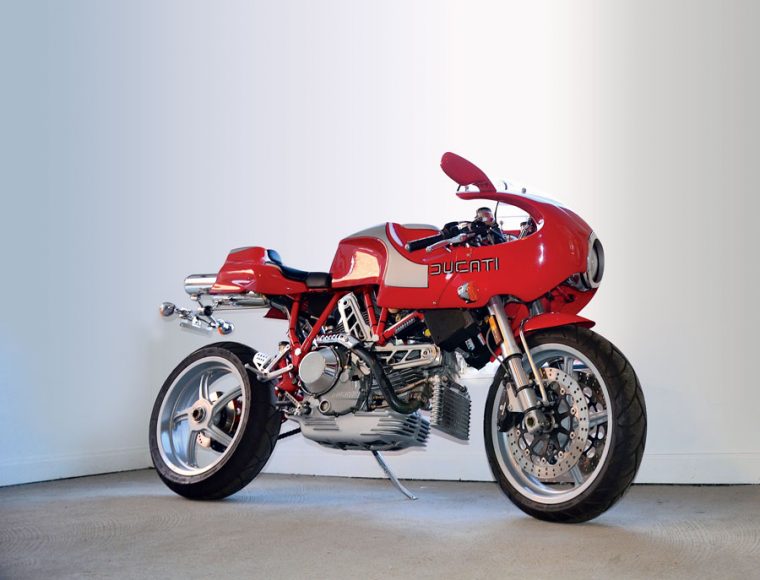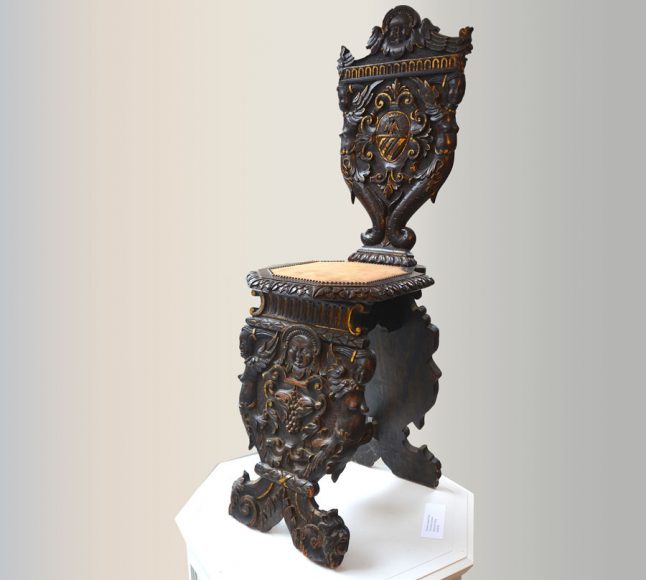Seeing a motorcycle when you peek in the window of the Gallarus Arts Space in Katonah might come as a bit of a surprise. However it fits perfectly into the exhibition, “High Design: Art Fueled by Function,” which is on display through March 31.
“The show is about objects that are functional, but also artful. They have a purpose to them but they also transcend their use,” says gallery owner and Katonah resident Greg Muenzen. He points out that the bright red 2001-02 Evoluzione Ducati MH900e motorcycle from Italy, which was designed by Pierre Turbinate, is a prime example. “The lines in it are incredibly evocative and it’s a sublime sculpture. I love that it conveys a sense of speed, adventure and total abandon, even when it’s completely still,” he says.
Whether it’s an ornamental French Renaissance cast iron fireback from the 1580s, a 17th-century gingerbread mold carved out of walnut or a 1950s American laminated wood bow, the pieces in the show were created to be handled and yet possess profound beauty. “In fact, I chose to display the bow on a pedestal because of its amazing minimalism and elegance,” Muenzen add. “It’s important to highlight that even ordinary objects that we work with all the time can be incredible and enrich our lives.”
In the back of the gallery are two 17th-century Florentine Sgabello, armless chairs popular in the Renaissance. Intricately carved out of walnut, the chairs are adorned with part-mermaid, part-griffin seminude female figures alongside cherubic faces with wings. “The kind of riotous, surreal sense of design is the reason why they’re in the show,” he says. “They’re just so ‘trippy’ that they’re almost contemporary in their wildness.”
Among the other pieces of furniture on display is a 1950s Baker chair by Danish architect and designer Finn Juhl (1912-89). “The teak chair has a lightness to it and is so poetic. Even though it’s supposed to house a body, it’s like a piece of architecture. I also love the way the designer wanted you to cherish the pure wood by leaving it blond and unfinished.”
Muenzen’s eye for design extends over to scientific objects as well. “I’ve included a 19th-century polished brass microscope that’s incredibly elegant. It shows jeweler-type work in terms of its chasing and finishing of the metal. And I like thinking about how this object evokes a whole period of time when scientists like Darwin were looking at the unexplored world.”
Muenzen, who is an artist as well as gallery owner, has two pieces on display in the show. One is a primitive-type sculpture made out of branches that is meant to evoke the Gallarus Oratory, an early stone church that was built in the Dingle Peninsula in Ireland in about 800. “What I was trying to conjure was the idea of the oldest sense of design that’s part of our DNA. Whether it’s Irish, American Indian, or any of the early communities in Europe, we all started with these structures.”
His other piece, the “Giant of Katonah,” is a wooden sculpture that alludes to the past of the charming hamlet. When the government decided to build a reservoir and flood the original Katonah in 1897, the townspeople had to move their homes and churches a couple miles away to the present-day location. More than 50 buildings were rolled on logs pulled by horses to the new site, a strenuous endeavor for all involved. The piece features an 8-foot architectural beam that Muenzen imagines as the size of a heroic person. “It’s in the show as a designed object because it’s resting on a pallet with wheels. I like the ambiguity of it: Is it a functional, is it architectonic or is it art?”
Also on display in the gallery is a collection of Old Master drawings by the painter Taddeo Zuccaro (1529-1566). (See sidebar.) Praised by Michelangelo, he rose to be one of the most accomplished draughtsmen of the late Renaissance. Muenzen points out that in some of Zuccaro’s pen and ink drawings there’s such fineness to the line work that it almost looks like the filigree of jewelry.
According to Muenzen, the two shows parallel each other. “Renaissance artists and sculptors like Zuccaro were trained in guilds, so oftentimes their early training was as objects designers. They created functional items such as silverware and candelabras, and there weren’t the divisions that we see today,” he says.
In addition to exhibitions, Muenzen also hosts multiple special events every month.
“I’ve always wanted to have a gallery that was very vigorous and vital. In addition to the artwork, we have poetry readings, live music, lectures and artist workshops. It’s a gallery that’s about ideas and being creative in the space.”
Among the upcoming events is a gallery talk on March 9 (3-4 p.m.) that coincides with the “High Design” exhibition. Titled “The Evolution of Greco-Roman Amorini into Renaissance Putti,” the art history discussion will include slides on ancient Greco-Roman sculptures of infants representing varied human emotions, which Renaissance artists such as Donatello and Michelangelo rediscovered and designed into their religious as well as secular sculpture commissions. In addition, the John Pondel Jazz Trio will perform a concert Saturday March 23 at 7 p.m. (with doors opening at 6:30). Both events are free.
When asked what he likes most about owning an art gallery, Muenzen says, “I love watching people interact with art. Perhaps you can notice that little bit of magic that comes across their face when they see something that hits them or intrigues them. Those are the special moments that I like to observe.”
For more, visit gallarusarts.com.





